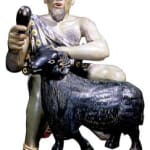Asante Polychrome Sculpture of a Man Holding a Black Ram, 20th Century CE
Wood
14.25 x 17.75
PF.3490 (LSO)
This remarkable polychrome piece is a contemporary masterwork from the Asanti/Asante (Ashanti) of Ghana. The portrayal is remarkable. A seated man – a chief, or at least a high-ranking official,...
This remarkable polychrome piece is a contemporary masterwork from the Asanti/Asante (Ashanti) of Ghana. The portrayal is remarkable. A seated man – a chief, or at least a high-ranking official, judging from his clothing and ornate stool – is grasping the right horn of a black sheep in his left hand and brandishing a club with is right, but appears to have been surprised in the act judging from his surprised expression. The central figure is painted with rather light brownish paint, while his robe is dark grey with yellow and white adornments. The stool is four-legged, with dark/.light interplay of geometric forms. The quality of the rendering is superb, with muscles, veins, hair and skin textures all picked out in remarkable detail. The rippling of the textile is also expertly captured.
The Ashanti/Asante are one of the many tribes that make up the Akan polity. The Akuapem, the Akyem, the Ashanti, the Baoulé, the Anyi, the Brong, the Fante and the Nzema all share general cultural trends while maintaining separate tribal identities. Their society is highly ritualised, with numerous gods under a main deity who varies according to the group in question (Onyame – the Supreme One – is the Asante deity), and a host of lesser gods (Abosom) who are mostly connected with the natural world (earth, ocean, rivers, animals etc). The society is ruled by Asantahenes, and a host of minor chiefs who claim royal status through their connection with the land and the founders of villages upon it. One factor that unites the Akan is the fact that they took a golden stool as their emblem and rose up against the European invaders in the 18th century. The Ashanti live in the central portion of the country, and are arguably one of the most important groups from the artistic point of view. Their Akuaba dolls are one of the most recognisable forms on the continent, while their fascination with gold (which the Akan consider a physical manifestation of life’s vital force, or “kra”) has given rise to a plethora of artefactual and artistic production.
The Asante are perhaps one of the best-adapted tribes in terms of dealing with the effects of colonialism. Their art has evolved – in the manner of the Yoruba sculptor, Thomas Ona – to depict and even lampoon European officialdom and the society it brought about. Likewise pieces such as this show not only the virtuoso potentialities of African carvers, but also demonstrate the fluidity with which they adapted – in this case capturing a slightly irreverent image of a chief or other prominent personage. The precise story behind who it represents is probably never going to become clear, but it remains a superbly rendered and sophisticated piece of African art.
The Ashanti/Asante are one of the many tribes that make up the Akan polity. The Akuapem, the Akyem, the Ashanti, the Baoulé, the Anyi, the Brong, the Fante and the Nzema all share general cultural trends while maintaining separate tribal identities. Their society is highly ritualised, with numerous gods under a main deity who varies according to the group in question (Onyame – the Supreme One – is the Asante deity), and a host of lesser gods (Abosom) who are mostly connected with the natural world (earth, ocean, rivers, animals etc). The society is ruled by Asantahenes, and a host of minor chiefs who claim royal status through their connection with the land and the founders of villages upon it. One factor that unites the Akan is the fact that they took a golden stool as their emblem and rose up against the European invaders in the 18th century. The Ashanti live in the central portion of the country, and are arguably one of the most important groups from the artistic point of view. Their Akuaba dolls are one of the most recognisable forms on the continent, while their fascination with gold (which the Akan consider a physical manifestation of life’s vital force, or “kra”) has given rise to a plethora of artefactual and artistic production.
The Asante are perhaps one of the best-adapted tribes in terms of dealing with the effects of colonialism. Their art has evolved – in the manner of the Yoruba sculptor, Thomas Ona – to depict and even lampoon European officialdom and the society it brought about. Likewise pieces such as this show not only the virtuoso potentialities of African carvers, but also demonstrate the fluidity with which they adapted – in this case capturing a slightly irreverent image of a chief or other prominent personage. The precise story behind who it represents is probably never going to become clear, but it remains a superbly rendered and sophisticated piece of African art.
Literature
V27



